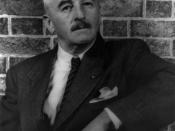In "A Rose for Emily," William Faulkner's use of language foreshadows and builds up to the climax of the story. His choice of words is descriptive, tying resoundingly into the theme through which Miss Emily Grierson threads, herself emblematic of the effects of time and the nature of the old and the new. Appropriately, the story begins with death, flashes back to the near distant past and leads on to the demise of a woman and the traditions of the past she personifies. Faulkner has carefully crafted a multi-layered masterpiece, and he uses language, characterization, and chronology to move it along, a sober commentary flowing beneath on the nature of time, change, and chance--as well as a psychological narrative on the static nature of memory.
Faulker begins his tale at the end: after learning of Miss Emily's death, we catch a glimpse of her dwelling, itself a reflection of its late owner.
The house lifts "its stubborn and coquettish decay" above new traditions just as its spinster is seen to do, "an eyesore among eyesores" (Faulkner, 666). The narrative voice suggests the gossipy nature of a Southern town where everyone knows everyone else, and nosy neighbors speculate about the affairs of Miss Emily, noting her often antiquated ways and her early retirement. In fact, it appears as if the town itself is describing the events of Miss Emily's life, the first-person plural "we" a telling indication. The first explicit example of this occurrence takes place during the flashback in the second section, when, in speaking of her sweetheart, the narrator parenthetically adds "the one we believed would marry her" (667).
In the opening characterization, many descriptive words foreshadow the ultimate irony at the climatic ending: "her skeleton was small and sparse," "she looked bloated, like a body long...


